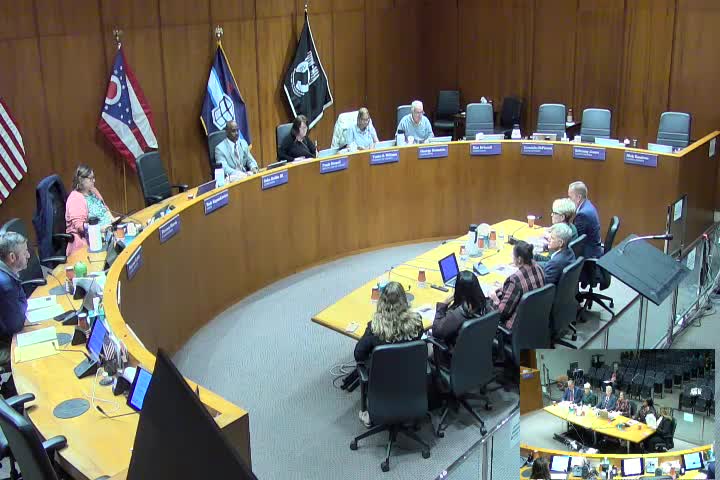CJCC tells Toledo committee it helped leverage $10.2 million and reports 42% drop in local jail population
November 10, 2025 | Toledo, Lucas County, Ohio
This article was created by AI summarizing key points discussed. AI makes mistakes, so for full details and context, please refer to the video of the full meeting. Please report any errors so we can fix them. Report an error »

The Toledo City Council Public Safety and Criminal Justice Reform Committee on Tuesday heard a broad update from the Criminal Justice Coordinating Council (CJCC) on reentry, diversion and data-sharing initiatives that CJCC leaders said have reduced pretrial and sentenced jail populations and expanded services.
A CJCC executive director told the committee the council, established by city ordinance and a county resolution in 1972, has helped the city and county leverage roughly $10.2 million in funding since 2014 and secured about $4.7 million in competitive federal grants for reentry programs. “We have realized … a 42% reduction in our jail population,” the presenter said, describing that decline as both pretrial and sentenced.
Why it matters: CJCC officials said the change followed Lucas County’s 2015 move from a charge-based to a risk-based pretrial system — including adoption of a Public Safety Assessment (PSA) tool — and the implementation of coordinated case-processing and reentry planning. The CJCC also participated in the MacArthur Foundation’s Safety and Justice Challenge, which county officials said awarded more than $5 million to Lucas County over a decade to reduce incarceration and improve public safety.
Presenters described a suite of strategies used to reduce unnecessary detention: a population-review team that meets weekly to expedite case processing; the Opportunity Project, which pairs social workers with public defenders in arraignment courts; diversion and community diversion programs; and targeted grants to reduce racial and ethnic disparities. One judge at the meeting summarized the core risk point: "When you assess risk, the greatest factor to predict whether a person is going to commit crime is whether they already have and whether they've been incarcerated," and argued reentry services reduce that risk.
What CJCC officials said they will do next: the presenter said CJCC is participating in a randomized-control evaluation by the Harvard Access to Justice Lab and expects statistically significant long-term results only after thousands of participants and multi-year follow-up. The presenter told the committee the Harvard evaluation will take time and that interim internal analyses had been inconclusive; they said they would provide materials and a QR code for further information.
Council response: Members praised CJCC’s longevity and statewide recognition but pressed for outcome data. Councilwoman Morris, citing constituent incidents in her district, said reducing jail populations “does not equal a safer community,” and asked for hard recidivism data that could reassure residents. CJCC presenters responded that preliminary self-reports show many participants learn new coping skills, while the rigorous Harvard study will take several years to yield definitive recidivism figures.
The committee did not vote on any new policy; presenters provided materials and offered to supply follow-up slides and interim evaluation output when available.
A CJCC executive director told the committee the council, established by city ordinance and a county resolution in 1972, has helped the city and county leverage roughly $10.2 million in funding since 2014 and secured about $4.7 million in competitive federal grants for reentry programs. “We have realized … a 42% reduction in our jail population,” the presenter said, describing that decline as both pretrial and sentenced.
Why it matters: CJCC officials said the change followed Lucas County’s 2015 move from a charge-based to a risk-based pretrial system — including adoption of a Public Safety Assessment (PSA) tool — and the implementation of coordinated case-processing and reentry planning. The CJCC also participated in the MacArthur Foundation’s Safety and Justice Challenge, which county officials said awarded more than $5 million to Lucas County over a decade to reduce incarceration and improve public safety.
Presenters described a suite of strategies used to reduce unnecessary detention: a population-review team that meets weekly to expedite case processing; the Opportunity Project, which pairs social workers with public defenders in arraignment courts; diversion and community diversion programs; and targeted grants to reduce racial and ethnic disparities. One judge at the meeting summarized the core risk point: "When you assess risk, the greatest factor to predict whether a person is going to commit crime is whether they already have and whether they've been incarcerated," and argued reentry services reduce that risk.
What CJCC officials said they will do next: the presenter said CJCC is participating in a randomized-control evaluation by the Harvard Access to Justice Lab and expects statistically significant long-term results only after thousands of participants and multi-year follow-up. The presenter told the committee the Harvard evaluation will take time and that interim internal analyses had been inconclusive; they said they would provide materials and a QR code for further information.
Council response: Members praised CJCC’s longevity and statewide recognition but pressed for outcome data. Councilwoman Morris, citing constituent incidents in her district, said reducing jail populations “does not equal a safer community,” and asked for hard recidivism data that could reassure residents. CJCC presenters responded that preliminary self-reports show many participants learn new coping skills, while the rigorous Harvard study will take several years to yield definitive recidivism figures.
The committee did not vote on any new policy; presenters provided materials and offered to supply follow-up slides and interim evaluation output when available.
View full meeting
This article is based on a recent meeting—watch the full video and explore the complete transcript for deeper insights into the discussion.
View full meeting
